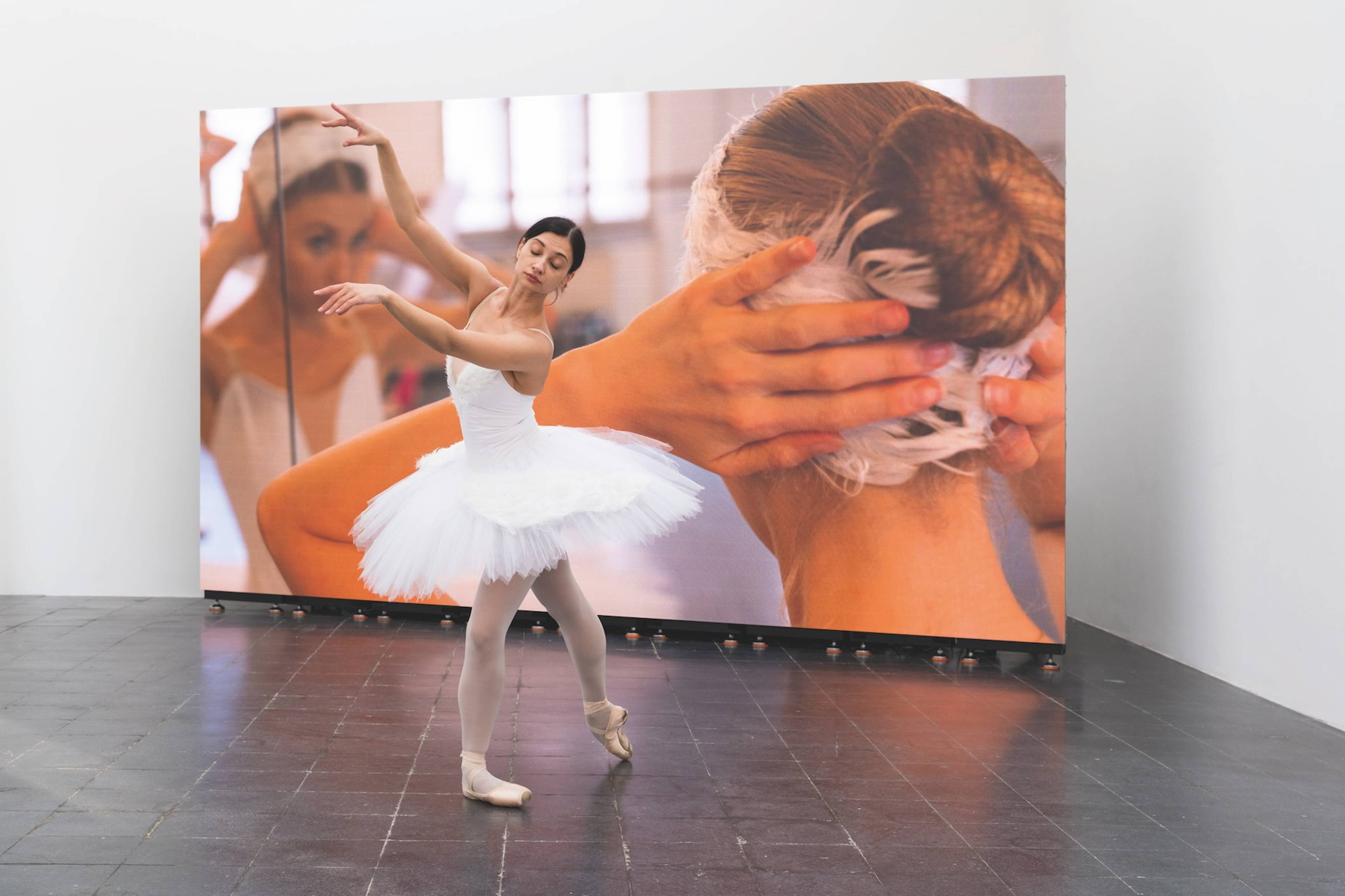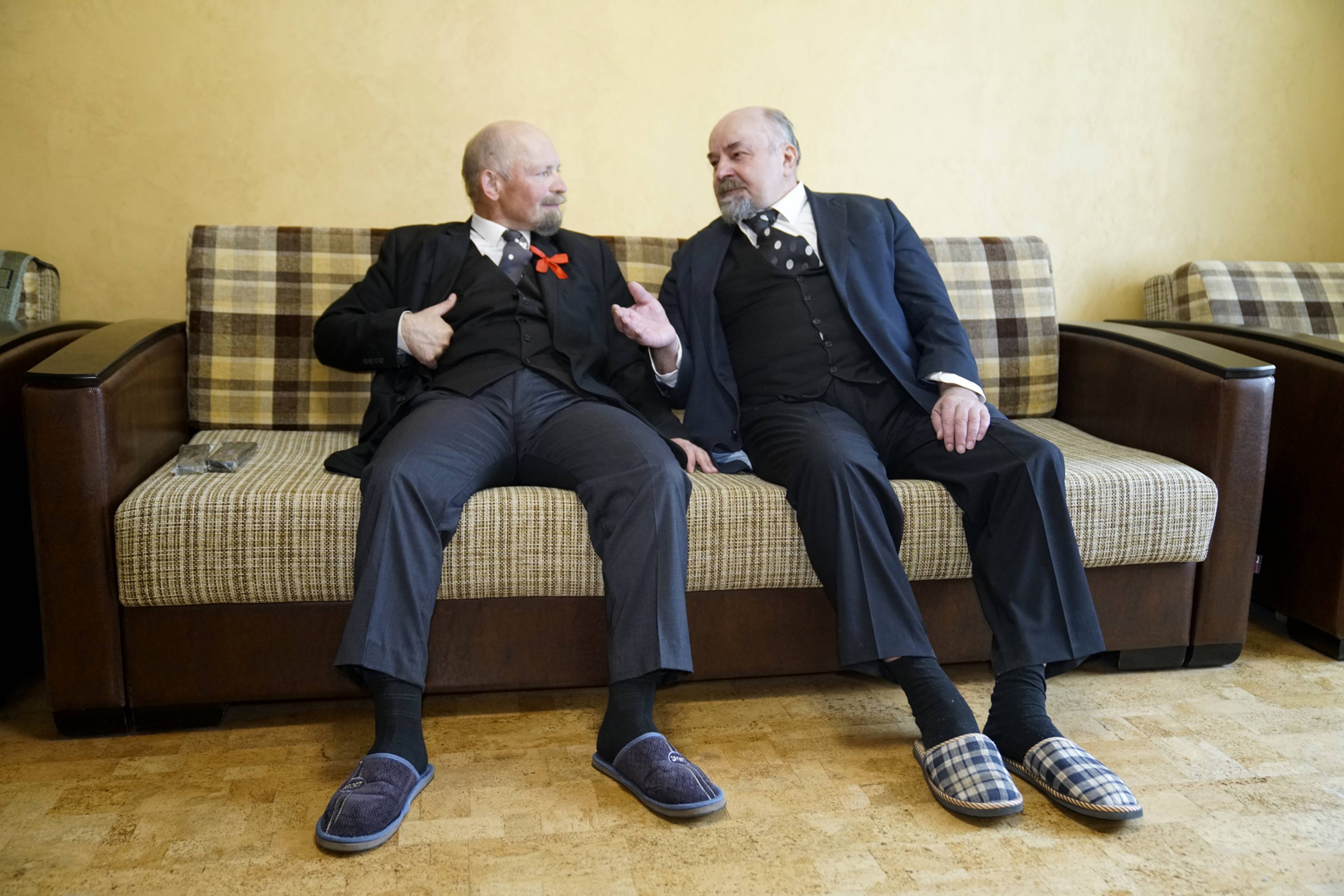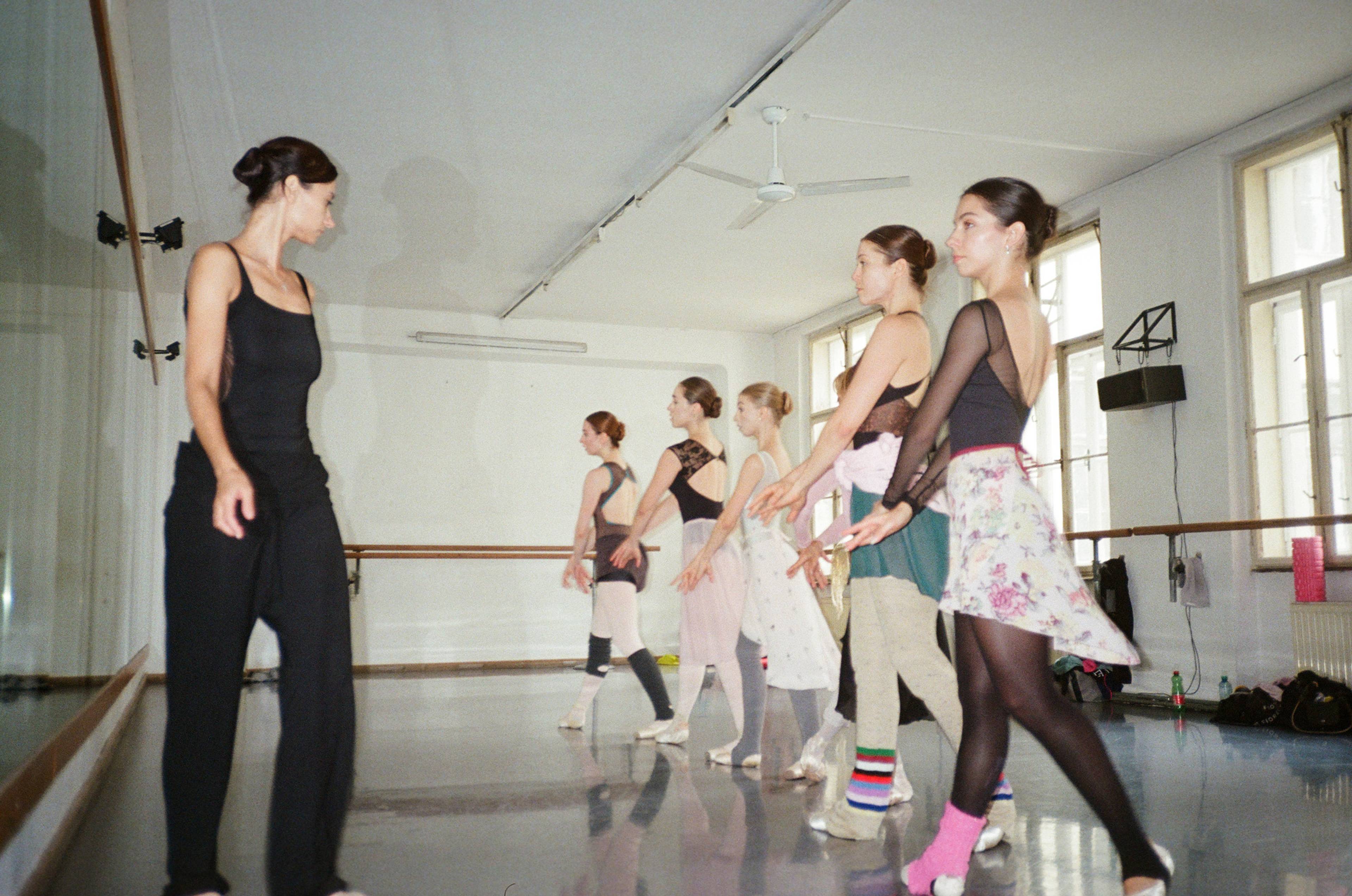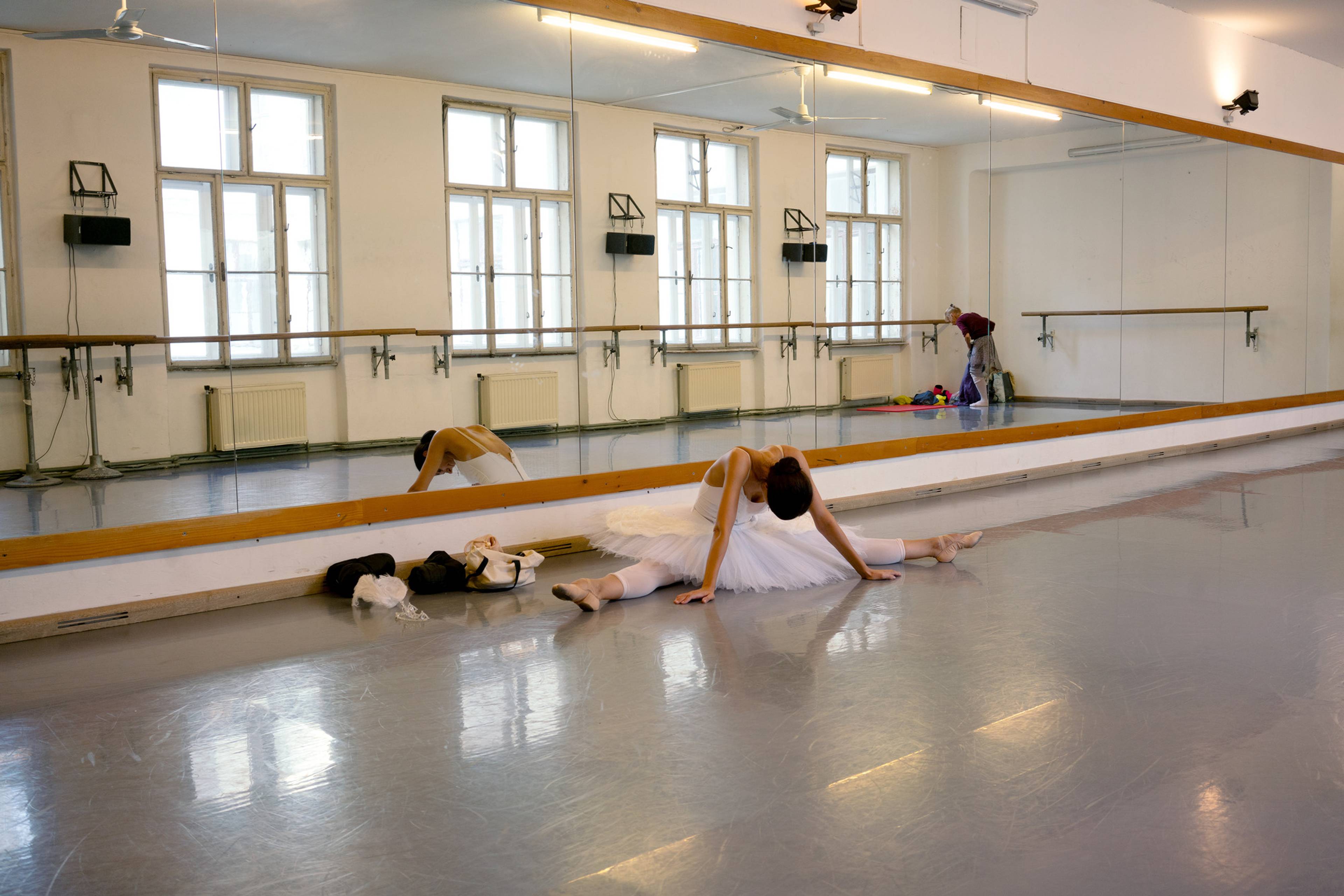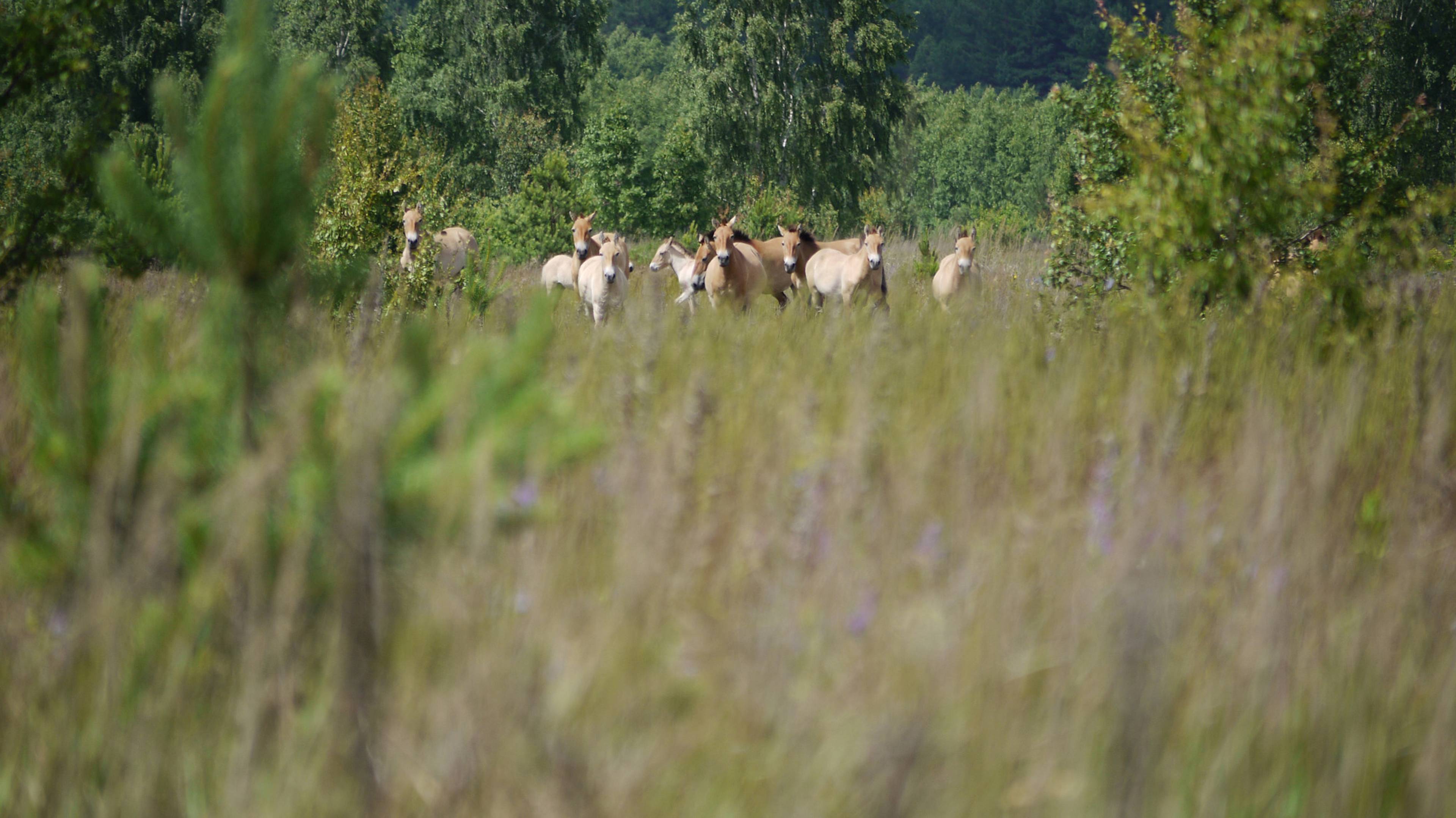Ballerinas sit in splits on the floor and stretch their toes in pointe shoes, then line up before a mirror for the “Dance of the Little Swans.” It is a routine that takes place every day in countless dance schools and ballet companies. But the rehearsals in Anna Jermolaewa’s video installation Rehearsal for Swan Lake (2024) are driven by a hidden desire: They long for the end of a tyrant.
“In my youth, I experienced three times that there was nothing but Swan Lake on Russian state television all day,” says Jermolaeva, who was born in St. Petersburg in 1970. A loop of the lulling, magical story was played for the first time in 1982, following the death of Soviet head of state Leonid Brezhnev. Instead of an official death announcement, the political power vacuum was bridged on state TV with endless dance. With Tchaikovsky’s most famous work as a news blackout, the Communist regime bought itself time to regroup behind the scenes.
“My Swan Lake is a call for a change of power. Anyone who has lived in a Soviet country understands this code,” says Jermolaeva. The saying “I hope that Swan Lake will soon be on TV” has become a way of wishing Putin to hell. The video Rehearsal for Swan Lake will be shown in the Austrian pavilion at this year’s Venice Biennale. The artist, who fled the USSR in 1989, collaborated with Oksana Serheieva, a dancer and choreographer who left Ukraine for Vienna in 2022, marking an increasingly rare joint project between Ukrainian and Russian artists. Together, they cast and conceived the scenes and filmed them like a documentary. “I want to make people more aware of the war again,” says Jermolaeva about her paradoxically utopian contribution, using, of all things, a most clichéd Russian cultural export as a protest against Putin.
Self Portrait with Dictator, 2007, digital print, 52 x 50 cm
Jermolaeva’s first appearance at the Biennale occurred the same year that the former KGB man came to power, in 1999. Her invitation reads like a fairy tale: One day, a student in a media class at the Vienna Academy of Fine Arts received an unexpected fax. The sender was none other than curator Harald Szeemann who Jermolaeva had met at an academy show. As director of the 48th Biennale, he brought her video installation Hendl Triptych (Chicken Triptych, 1998) to the Arsenale, where three screens showed grill baskets and rotating spits of sizzling chickens. “This unembellished performance awakens the idea of victims of our consumption and progress, of inventions for penning-up and mass annihilation,” Szeemann wrote about the work, praising its “compelling frontality.”
From the very beginning, Jermolaewa has drawn her ideas from everyday life. Using her daughter’s toys in videos like Solo (featuring a drumming bunny, 1999) Crashtest (with a toy car, 2002), or Kiss (starring Mickey Mouse masks, 2006), she created laconic symbols of violence and the pressure to conform. The artist raises deeply existential questions with deceptively simple forms, as in Trying to Survive (2000), which features an army of wriggling roly-poly dolls that refuse to fall or stay down. In our interview, she rejects her categorization as a “political artist” in blunt terms: “All art is political!” emphasizes Jermolaewa, who admires the German Conceptual artist Hans Haacke and the Russian dissident performers Pussy Riot.
“Today, millions of people are on the run. At the Biennale, I want my older works to speak for these people too.”
Jermolaeva’s own dissidence dates to at least her time attending a conservative art lyceum, where her drawing lessons involved painting workers and collective farmers in the style of Socialist Realism. At seventeen, she married the Ukrainian poet Vladimir Yaremenko and co-founded the USSR’s first opposition party, printing its weekly newspaper at her home until it was raided by the KGB in 1989. Despite glasnost and perestroika, the couple were accused of “anti-Soviet agitation” and only avoided prison by fleeing via Poland to Vienna, where they ended up in a home for asylum seekers. Several of Jermolaeva’s works refer back to these experiences, not so much to subjectively process them as to make tangible the vulnerability and discrimination that migrants face.
“Today, millions of people are on the run. At the Biennale, I want my older works to speak for these people too,” says the once politically persecuted artist, who has held an Austrian passport for thirty years. Shortly after arriving in Austria, Jermolaeva slept for a week in a Vienna train station, an experience she returned to seventeen years later for the video performance Research for Sleeping Positions (2006). The artist can be seen in a coat and jogging pants, sitting on a bench with her eyes closed. Her contorted sleeping positions dramatize the seats’ “hostile design,” the armrests of which prevent homeless people from lying down. Jermolaeva appears directly or indirectly in many of her works, not so much playing roles as acting as a representative of a critical civil society. In a 2007 photo showing her next to a wax figure of Putin, Self-portrait with Dictator, her serious gaze, the black background, and the title accuse not only the Russian president, but a Western public that courted him regardless of his autocratic rule. The Musée Grévin wax museum in Paris only mothballed its Putin figure in March 2022, after his war of aggression against Ukraine had made him unfit for visitor selfies.
Still from The Doubles, 2021, video
Her self-portrait follows a strategy of subversive affirmation. By getting close to Putin and posing with his idol-like figure as in a tourist photo, she questions the relationship between celebrity culture and real politics. By contrast, her video installation The Doubles (2021) is light and humorous, comprising interviews with men who, fit out like doubles of Soviet and Russian rulers from the past century, offer joint photos to Red Square tourists and can be booked as party gags. Wearing glued-on beards or painted-on scars, these men tell frankly that Stalin will rise again and that Gorbachev only appealed to Westerners, their stories mixing “Ostalgie” with capitalist business acumen.
“I am interested in subversive gestures in anti-democratic countries, a coded aesthetic.”
Jermolaewa pushes with great tenacity into how people remember and forget in the wake of socialism, building bridges to the present that have taken even her by surprise. Her wintry 2012 video GULAG documents a trip to Siberia to find out more about her great-grandparents, farmers who had been exiled to a labor camp under Stalin in 1930. While she was in the area, she received a tip that Pussy Riot’s Maria Alyokhina was imprisoned nearby, her location unknown even to her own parents. Jermolaeva was unable to meet the activist singer, but bought her food, cosmetics, and cigarettes in the prison store and informed Alyokhina’s lawyer as to where she was being held.
Anna Jermolaewa & Oksana Serheieva, Rehearsal for Swan Lake, 2023. Photo: Anna Jermolaewa
Anna Jermolaewa & Oksana Serheieva, Rehearsal for Swan Lake, 2023. Photo: Anna Jermolaewa
Time and again, Jermolaeva finds catchy formulas to expose manipulation. At the 2015 Moscow Biennale, she responded to the curatorial motto “How To Gather?” with Political Extras (2015), a fake demonstration involving 100 hired performers. Half carried banners with slogans in favor of the Biennale, the other half against. Paid-for rallies are commonplace in Russia, not only by political forces, but also by the media. The work may have also indirectly addressed the controversial nature of the publicly funded exhibition, which was widely viewed domestically and abroad as a liberal fig leaf obscuring a tightening censorship regime.
“I am interested in subversive gestures in anti-democratic countries, a coded aesthetic,” says Jermolaewa. Her 2017 installation The Penultimate fragrantly fills the exhibition space with vases of flowers. Each varietal stands for a non-violent resistance movement, such as the 1974 Carnation Revolution in Portugal, Georgia’s Rose Revolution in 2003, and the 2004 Orange Revolution in Ukraine, where Jermolaewa has family ties and has worked extensively. Her 2016 installation LENINOPAD focuses on Soviet monuments that were preserved in many villages into the 2010s and were only brought down by a “decommunization law” in 2015, following the annexation of Crimea. Besides photographing the empty pedestals, Jermolaeva interviewed people who had lived their entire lives with these figures, many of whom regretted the overthrow of local history along with their local landmarks. Her 2022 solo show at MAK, Vienna, opened two weeks after the full-scale invasion, heightening the salience of her Chernobyl Safari (2014/21). The installation showed videos and photos of wild horses that had miraculously thrived in the radioactively contaminated zone around the nuclear power plant. What Jermolaeva had captured as a symbol of beauty, freedom, and resilience had come under threat from Russian tanks driving through the restricted area.
Still from Chernobyl Safari, 2014/21, video
“I had the feeling that art had lost all its relevance,” Jermolaewa says of the “paralysis” that set in with the beginning of the war, when she began organizing transport and other aid for refugees arriving in Vienna instead of working in her studio. Two years on, there is still no end to the fighting in sight. Nevertheless, the artist meets the Russian despot, who has led Ukraine to the brink of an abyss and forced millions of people abroad, with an unexpected lightness. She takes us behind the scenes, where awaiting change means rehearsing the performance for a liberatory day X, her call for a new regime wearing a tutu and singing to Russian cultural memory. The doors of the Russian Pavilion will stay closed again this year. But Jermolaewa’s piece opens a window to a future, where the tyrant has lost the battle between the white and black swans.
___
– This text appears in full in Spike #79 – The Pessimist Issue. You can order your copy in our online shop –


